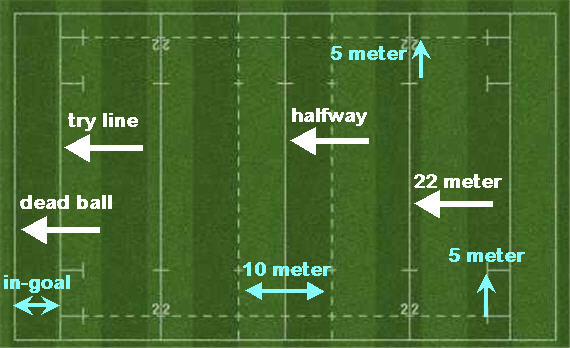You’ll see plenty of dashed and continuous lines on a rugby pitch. These don’t just mark specific distances. They play a crucial part in the rules of play.
We’ll explain the meaning of all the rugby pitch lines in this article:
- 10 meter line
- 22 meter line
- 5 meter line
- Dead ball line
- Halfway line
- Touchline
- Touch-in-goal line
- Try line
Diagram Of Lines On A Rugby Pitch
This diagram lays out all the lines on a rugby pitch.

Let’s run through each one.
10 Meter Line
There is a dashed 10 meter line on either side of the halfway line.
When a game is restarted with a kick-off, the kicker must kick the ball past the 10 meter line.
You may think that this will always happen. But there is a tactic where kickers put up a high but short ball to allow teammates to compete and catch it.
If the ball doesn’t travel past the 10 meter line, then the referee will whistle for an infringement. The opposing team has the option of receiving the kick-off again or a scrum on the halfway line.
As the opposition team gets possession of the scrum, they always make this choice!
22 Meter Line
Unlike some other lines, the 22 meter lines are continuously drawn (i.e. not dashed). They run horizontally across the pitch at a distance of 22 meters from each try line.
Players can kick the ball into touch from behind their 22 meter line, and the line out is at the point that it crosses the touchline.
If they are outside the 22, they have made a big mistake. In this case, the line out occurs at the point that they kicked the ball.
This line also marks where the kicker stands for restarts with a 22 meter drop-out.
5 Meter Line
There are two types of 5 meter lines. These lines are dashed i.e. not continuous.
A line runs horizontally across the pitch, five meters from each try line. When a team is awarded a five-meter scrum, they pack down on the 5-meter line.
The other type of line runs vertically, five meters in from each touchline. When the ball is thrown in at a line out, it must travel at least to the 5 meter line.
Five Meter Scrums
5 meter scrums are awarded when a ball carrier takes the ball across the opposition try line but is stopped from grounding the ball by a defender who gets hands or body beneath it.
Dead Ball Line
The dead ball line is the final continuous line at either end of the pitch behind the posts.
If the ball flies or rolls over the dead ball line, then play is stopped. Often this is the result of a kick at the posts.
But sometimes, a player misjudges a tactical kick and rolls over the dead ball line.
This is an advantage to the opposition. They can choose a scrum from where the ball was kicked or a drop-out on the 22 meter line.
Halfway Line
The halfway line is a continuous line that runs horizontally across the pitch.
When players run out onto the pitch at the start of the first and second half, each team gathers on either side of the halfway line.
They can’t cross the line until the kick-off.
The halfway line is also the point of kick-off after a score.
Touch Line
The touchlines are continuous vertical lines that mark the playing boundary on either side of the pitch.
When any point of the ball touches the touchline, it is out of play. This is unlike a sport like soccer where the ball must fully cross the sideline.
Ball carriers
This also applies when any part of the ball carrier’s body makes contact with this line. You’ll see players throw the ball infield or wriggle sharply away if they are tackled close to the touchline.
You’ll also see canny defenders grab an ankle of the tackled ball-carrier to pull the boot to the touchline.
Touch-In-Goal Line
The touch-in-goal lines are the short sidelines between the touchline and the dead ball line.
If an attacker attempted to ground the ball but it made contact with the touch-in-goal line, then a try is not awarded.
Try Line (Or Goal Line)

The try lines are continuous horizontal lines running through the goalposts at each end of the pitch.
The attacking team is awarded a try when the ball carrier grounds the ball either on or past the touchline. Just the tip of the ball needs to touch the whitewash of the try line.
The goalposts obviously interrupt the continuous line, particularly as they now have deep padding to protect players.
For a time, the padding became part of the try line
What happens if the ball carrier touches the ball against the post or padding? The laws around this have changed several times.
Originally, the ball had to touch the line. This was before the advent of padding.
If the defenders managed to make it stick in front of a post (best helped with lots of mud), the try was not awarded.
But players were getting injured as rucking and mauling got caught up with the posts. So, padding was introduced.
But the thick padding took away ground for scoring a try. The laws were changed so that a try was awarded if it touched the padding.

The laws changed so that the padding is not part of the try line
Players often adapt to laws in a way that authorities do not want.
In 2019, Edinburgh were playing Munster. Edinburgh were defending on their line and close to the posts. One of the Scottish players hoisted up the padding to waist height.
This made it more difficult for a Munster ball-carrier to lunge forward towards the posts for a try. Of course, this makes the game more dangerous.
The rugby authorities acted quickly. They reversed the law change that allowed grounding against the protectors.
Once again, a try must be scored by grounding on or past the try line.
Dimensions Of A Rugby Pitch
There isn’t a single set of dimensions that rugby pitches must conform to. This is due to the evolving history of rugby clubs and grounds.
However, the rugby authorities set a maximum and minimum length and width of pitches.
- A rugby pitch can be a minimum of 94 meters to a maximum of 100 meters.
- The width of the pitch can be a minimum of 68 meters to a maximum of 70 meters.
There is more variation allowed for the in-goal area. This can be a minimum of 6 meters and a maximum of 22 meters.
This table summarizes the allowed dimensions:
| Dimension | Minimum | Maximum |
| Length | 94 | 100 |
| Width | 68 | 70 |
| In-goal | 6 | 22 |
What about touch rugby?
Because pitch widths tend to be 70 meters, this happens to be the standard length of touch rugby pitches.
The touch games tend to be played across the standard pitch because there are less players. If you want to read more, these articles explain the background: